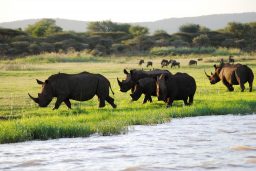Rhinos are very fast off the mark and when they want to they can run as fast as a zebra or ostrich – which is still way faster than a top-flight human sprinter.
How Fast Do Rhinos Run When Charging?
Just like with us humans, rhinos are fastest over just a short distance – the most important distance. Rhinos are very short-sighted and so will only usually charge something that threatens them if it is close enough to see – then their charging distance is perfect. Most rhinos that are far away or are well aware of you or something else moving in the distance – will simply move away. Phew. You did not want to be near a charging rhino.
The average rhino charge is 30% faster than the (well-trained top-flight) human sprinter over 100m – but what is it like compared to the average untrained human who is simply out on a lovely safari?
As An Average Human: Can You Outrun A Rhino?
No, you can’t. Along a flat surface, you would be caught up in seconds. Unless the rhino runs the wrong way (short-sighted), falls down a hole or you are right next to a deep river (rhino can’t really swim very well) – you don’t stand a chance. Even with your Nike trainers on and a head start – it is still no competition.
The table below shows some comparisons over an estimated 100m sprint:
| Animal: Top Speed (Ave) | km/h | mph |
| Black Rhino | 55 km/h | 34 mph |
| Sumatran Rhino | 55 km/h | 34 mph |
| Indian Rhino | 50 km/h | 34 mph |
| White Rhino | 50 km/h | 31 mph |
| Javan Rhino | 50 km/h | 31 mph |
| Olympic Human | 45 km/h | 28 mph |
| Average Human | 9 km/h | 5,5 mph |
Clearly – we aren’t going to be outrunning any rhinos anytime soon – so stay clear of rhinos when on foot!
What Animals Can Run Faster Than A Rhino?
What animals out there can actually run faster than a rhino at a sprint – even if they aren’t in the same country? Elephants? Bears? Horses? Luckily most of the running speeds referred to online and below are top speeds for only short bursts and only for adults of the species.
Most species would rather not run at full speed for any longer than they need to – and apart from humans and trained domestic animals – they only run at these top speeds when they are scared or incredibly angry!
Anyway – let’s club all the rhinos together at the 55km/h (34mph) mark for ease and go from there. So who is around the same speed or faster top speeds?
| Animal: Top Speed (Ave) | km/h | mph |
| Cheetah | 112 | 70 |
| Pronghorn | 98 | 61 |
| Quarter Horse | 88 | 55 |
| Lion | 80 | 50 |
| Kangaroo | 70 | 43 |
| Ostrich | 64 | 40 |
| Tiger | 58 | 36 |
| Moose | 56 | 35 |
| Rhino | 55 | 34 |
| Wolf | 55 | 33 |
| Grizzly Bear | 48 | 30 |
| Elephant | 40 | 25 |
| Hippo | 30 | 19 |
Can a Rhino Swim Faster Than It Can Run?
The rhino’s swimming abilities and speed are not as impressive as its running prowess. Rhinos are not built for aquatic movement, with their heavy bodies and short legs hindering their speed in water. On land, however, they can charge at speeds up to 30 miles per hour, making them formidable runners.
Do Rhinos Attack Humans?
Luckily for humans – rhinos are responsible for only a handful of attacks each year – compared to something like hippos or crocodiles. Rhinos generally will avoid humans or anything that makes a commotion – they are mostly forest-dwelling and shy.
Not so for the Black Rhino – who is always up for a fight. They fight so fiercely with anything – including each other – that around 50% of rhino fights end up in a fatality. They really are the one to avoid out of all the rhino species – however they look almost identical to the White Rhino, which shares a majority of its habitat, so unless you can see their top lip (Black Rhinos is pointy) or know about the specific tell-tale signs – steer clear of ANY rhino in Africa – and hippos for that matter.
Rhinos don’t go out looking for humans to attack thankfully – they aren’t prey-driven as they are herbivores. And like most herbivores, they only attack when they are threatened – or have a calf. Thankfully so, because at their huge size and great speed they could bring down walls and turn over cars – and we wouldn’t stand a chance if they came looking for us. Luckily though they are big and easy to see a long way off!
Indian, Sumatran, and Javan rhinos (in Asia and South-East Asia) are more well concealed. They move through the thick undergrowth of the forests and mountains of their home range and so are seen by humans less often. Again, these three species are more likely to leave an area if they hear a disturbance – but if threatened or lose sight of their calf – they could become defensive.










